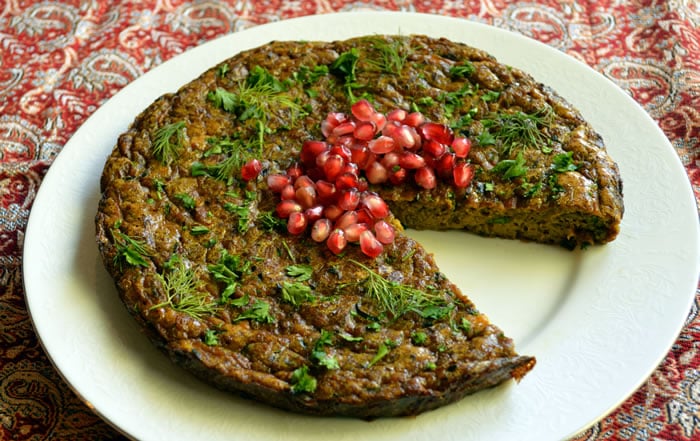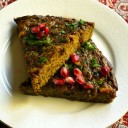Kuku Kadoo
Oct 18, 2014, Updated Aug 18, 2017

I still vividly remember the moment I first pledged to October Unprocessed. It was back in 2012 and I was in the midst of a Googling frenzy about eating healthier.
Now I didn’t have a terrible diet by any means, but I knew it wouldn’t win any prizes for the healthiest. I could feel it. Too often would I feel sluggish or miss a workout, especially after a take-out meal or a junk food binge. I didn’t like it. So hey, what the heck, October Unprocessed was at least worth a shot. I vowed to go unprocessed the whole month.
Honestly, only the first day was really difficult for me, and it was all in my mind. I dreaded the prospect of changing my diet altogether and “reinventing” what I ate. I thought that a successful October Unprocessed would require a drastic dietary change from me. But as luck would have it, I wouldn’t have to at all.
I’d just have to eat more Persian food.
Granted, I’m half-Persian and grew up in a large Persian family, so it was under my nose (literally!) the entire time. It just never dawned on me that Persian food could be such a perfect fit for my new, unprocessed journey.
Yet it’s just that. Even in many restaurants, Persian (or Iranian) meals are always prepared with ingredients that’ll pass every Kitchen Test with flying colors.
Iranian cuisine is also pretty healthy and a well-balanced diet. Rice is the staple of most every meal, but each meal must also contain vegetables, nuts, herbs, fruits, and a protein in some fashion. Then, on the side, there’s the requisite plate of fresh green herbs–sabzi khordan–for additional healthful side snacking.
But what really sets Persian cuisine apart is the amazing spices and other flavorings. Ingredients like saffron, dried limes, and rosewater are what really uplift Persian dishes into an entirely different, super-flavorful stratosphere. And so it was – my first October Unprocessed was full of Persian food. What a glamorous time it was.
Little would I know how impactful this deepened indulgence in Persian food would really be. As a cooking enthusiast, albeit a total amateur, I devoted all my cooking attention that October learning every type of Persian dish. And make no mistake… there are a lot out there.
It was that October of “Persian recipe study,” for which I’m grateful at how very patient and cooperative my girlfriend Heather was, that the floodgates really opened. We had so much fun learning and diving deep into the nuances of the Iranian cuisine that we challenged ourselves to do it again. And so we spent November tackling another entirely different cuisine altogether: Vietnamese.
Now, Heather and I have a blog devoted to this sort of deep-diving and cuisine learning. And we have October Unprocessed 2012 to thank for the genesis of the idea.
And since that first October Unprocessed, I’ve successfully shed all other bad food habits and have been eating right. It’s been two years since we last ordered take-out, and the only pizzas we eat now are homemade.
I’d like to challenge all October Unprocessed pledgers to use this time to break old food habits and to freely discover new ones. Let this month be the catalyst that brings you your new perfect meal or a cleaner, healthier way to prepare an old favorite.
To help you on your journey and to introduce Persian cooking, I’ve got here for you an exquisite (and super-simple!) recipe for Kuku Kadoo, an Iranian-style frittata with zucchini.

Kuku Kadoo
Ingredients
- 5 eggs, beaten
- 3 tablespoon olive oil
- ¼ teaspoon minced fresh ginger
- 2 large onions, chopped
- 3 cloves garlic, minced (we personally love garlic and put more, but that's just us)
- 4 small zucchini, grated
- 1 teaspoon ground turmeric
- 1/2 teaspoon baking soda
- Kosher salt and freshly ground black pepper, to taste
Optional, but Highly Recommended
- 2 threads saffron
- pinch of sea salt or any ground spice
- 2 tablespoon boiling water
Possible Garnishes
- 5 tablespoon chopped parsley
- Pomegranate seeds
Instructions
Prep Work
- Pre-heat oven to 400°
- Crack eggs into mixing bowl and whisk thoroughly
Phase 1
- Place onions into skillet over high heat. Let onions begin to sweat (with or without a tablespoon of oil is at your discretion)
- As onions sweat and cook, gradually add oil over a course of 5-8 minutes
- As onions start to brown and piaz dagh is made, add ginger and garlic and turmeric. Cook on high heat for another minute
- Add grated zucchini and lower to medium-high heat. Cook until tender roughly 10-12 minutes
- Optional: With 2-3 minutes remaining on the zucchini, add the saffron water (instruction below)
Phase 2
- Take zucchini and onion mixture off heat and add to beaten eggs. Mix thoroughly
- Add baking soda, salt, and pepper to egg mixture
- Pour mixture into casserole dish and place into oven. The kuku will be done in 25-30 minutes or until you see a solid golden brown top on the kuku
- Remove from oven and garnish with pomegranate seeds and parsley
Saffron water
- Place strands of saffron into mortar and pestle with the pinch of salt or spices. Grind down.
- Place ground mixture into small bowl or ramekin with boiling water
- Let mixture sit for at least 5 minutes as saffron flavor opens up
Notes
Nutrition






















Made this last night and it came out amazing! I can’t believe I was able to make it to turn out so well. Thank you for sharing the recipe and cooking tips!
Our pleasure, Shana! Really glad you liked it!
how much brown sugar to use when grinding saffron?
Just a tiny tiny pinch Sandy, but really anything will do here like a pinch of salt or a spice. The intention is to give the saffron something to “cling onto” as it gets ground down more than anything else
Ah, I goofed that up when I posted the recipe, sorry about that. I just updated the recipe to specify a pinch of salt or spices instead of brown sugar. It’s a better unprocessed option. 🙂
This sounds delicious! What size casserole dish do you use?
Thanks Shana!
This time around, we used a 9.5″ round dish, which was actually the perfect size for the proportions we made. That said, it’ll work in any type of dish you have!
Hi Shana,
We used an oven-safe glass pie dish that was 9.5″ diameter.
I freeze my garden zucchini in shredded form in the summer for use over the winter. Would it work here? When I thaw zucchini, I find that it gives up a lot of its water. I usually toss out the water when I make zucchini bread. If you think it would work, roughly what volume (I measure and label before freezing) should I use?
Hm… that’s a really good question Amy!
This would be my best guess, but if you’ve done away with most all of the water once they thaw, then you could go ahead and 1.5x or even 2x the amount of zucchinis used in the recipe. For a dish like kuku (and there are many types of it), you really can’t go wrong with having more of the staple ingredient in there
I’d be curious to see how that comes out.. would you mind letting us know how it goes?
Either way–I want to make it. The pomegranates add nice eye candy.
Not just that, but they add a great burst of taste to the dish as well.
Let me know how it goes when you make it!
Love this recipe Cyrus. I have a question about the baking soda–what does it do to the frittata/veggies?
Have you made it without the baking soda and what was different?
Thanks Letty! Really glad you like it
The baking soda here more acts as a leavening agent.. just to make the kuku more fluffy in the end. It’s completely optional, though, I know many a Persian that don’t put any in at all and yield just as amazing end results 🙂